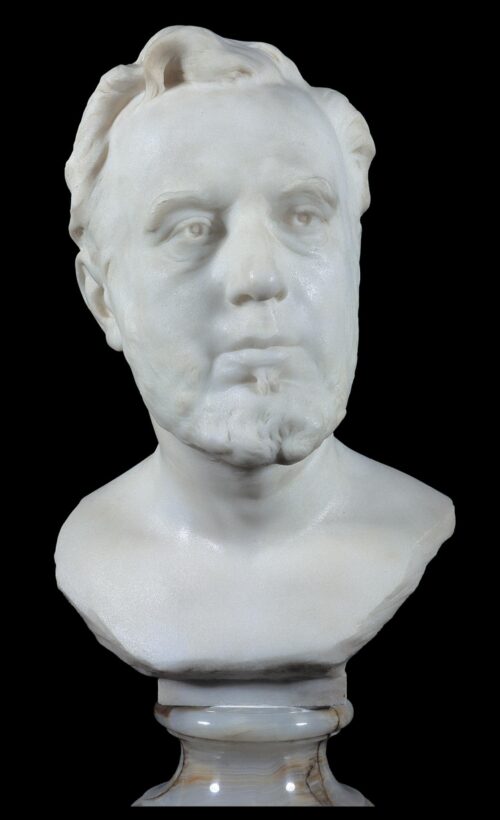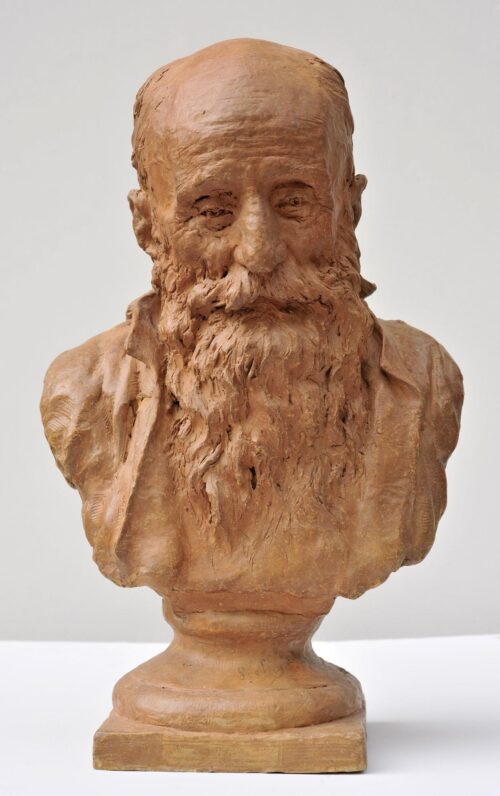
Sochos Lazaros (1857/1862 - 1911)
Dimitrios Vikelas, 1892
He first studied at the drawing school of a Frenchman called Guillement in Constantinople. Then, with the help of the Zarifis family, he studied at the Athens School of Arts, sculpture with Leonidas Drossis and painting with Nikiforos Lytras. In 1881, with the financial support of Therese Zarifis, he went to Paris, where he enrolled in the Ecole des Beaux Arts and worked with the sculptor Marius Jean Antonin Mercie. In 1897, he fought in the Greek-Turkish War in a volunteer corps. In 1901, he returned to Greece in order to erect the statue of Theodoros Kolokotronis in Nafplio, the model for which he had prepared at Mercie’s workshop, in 1891-1895. The work was shown in the 1900 Paris International Exhibition, where it won the gold medal; it was also awarded by the Academy of Rome. In 1904, a second copy was set up in Athens. In 1908, Sochos was appointed professor of sculpture at the School of Arts. He collaborated with the Archaeological Agency and participated in the restoration of the Lion monument at Chaeronea and the reconstruction of the Olympia sculptures. He was founding member of the Society of Greek Artists and member of several art committees.
His work was presented at the 1888 Olympia exhibition in Athens, the 1900 Paris International Exhibition, the exhibitions of the Society of Greek Artists (1907-1910) and the Rome International Exhibition (1911).
Lazaros Sochos lived during a period of transition for Modern Greek sculpture, when neoclassicist ideals coexisted with a shift towards realism and the plastic ideas mainly emerging in Paris and Rodin’s work. His style was shaped by influences received during his apprenticeship with Drossis and his sojourn in the French capital, where he was mainly associated with sculptors representing academic sculpture, and thus never shedding his neoclassicist background. Believing that sculpture is an art of educational and moral purport and that Modern Greece could be revitalised through its classical past, he operated in the context of neoclassicism and idealism. In his works – mainly busts, monuments, reliefs and medals – a heroified figure prevails, reflecting his idealistic views, which informed both his creative career and his life.

Dimitrios Vikelas, 1892

Bust of a Clergyman (probably Theophilos Kairis), 1889

We use cookies to make our site work properly, to personalize content and ads, to provide social media features and to analyze our traffic. We also share information about how you use our site with our social media, advertising and analytics partners. Read the Cookies Policy.
These cookies are necessary for the website to function and cannot be switched off in our systems. They are usually only set in response to actions made by you which amount to a request for services, such as setting your privacy preferences, logging in or filling in forms. You can set your browser to block or alert you about these cookies, but some parts of the site will not then work. These cookies do not store any personally identifiable information.
If you disable this cookie, we will not be able to save your preferences. This means that every time you visit this website you will need to enable or disable cookies again.
These cookies tell us about how you use the site and they help us to make it better. For example these cookies count the number of visitors to our website and see how visitors move around when they are using it. This helps us to improve the way our site works, for example, by ensuring that users find what they are looking for easily. Our website uses Google Analytics for statistics reporting.
Please enable Strictly Necessary Cookies first so that we can save your preferences!